WORLD CLASS COACHING
Developing Soccer Intelligence Through 4v4 Vol 3
By Philip Cauchi
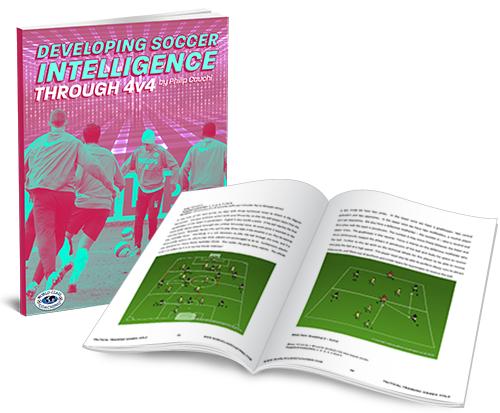
Table of Contents
PART THREE
Progressive Sessions
Progressive Sessions
Session number: 18.
Moment of the game: Opponents in possession.
Team task: Prevent scoring.
Aim: Prevent opponents from scoring, win the ball and initiate the counter.
Technical-tactical outcomes:
1. Closest (first) defender applies pressure on the attacker with the ball.
2. Angles of coverage
3. Distance between players.
4. Overload ball area.
5. Mark opponent ball-side.
6. Defender in line between the attacker with the ball and the goal.
Duration of session: 87 to 90 minutes.
Number of players: 16 outfield players and 2 goalkeepers or we may rotate players as goalkeepers.
Equipment:
Bibs – one set of eight plus another colour for the neutral players.
Markers – to mark areas.
Regular goals – two.
Mini goals – four (two setups).
Session plan:
1. Movement preparation and agility: 18 minutes.
2. Technical-tactical activation – 1v1 recovery defending: 10 minutes.
3. Game 1 – Defend outnumbered and counter in a numerical advantage: 20 minutes.
4. Practice – 1v1 with the attacker receiving with his back to the goal: 10 minutes.
5. Game 2 – Defend outnumbered, win the ball and counter rapidly: 26 minutes.
6. Conclusion and recapitulation: 5 minutes.
N.B. If we do not have four regular goals and/or goalkeepers, for the games and practices we can have one group of eight players playing the four goal game while the other plays the game shown in this session plan. After two series the groups rotate.
Movement preparation and agility.
1. Multi-lateral footwork (8 minutes).
2. Dynamic flexibility (5 minutes).
3. Tag game (5 minutes).
Technical-tactical activation – 1v1 recovery defending.
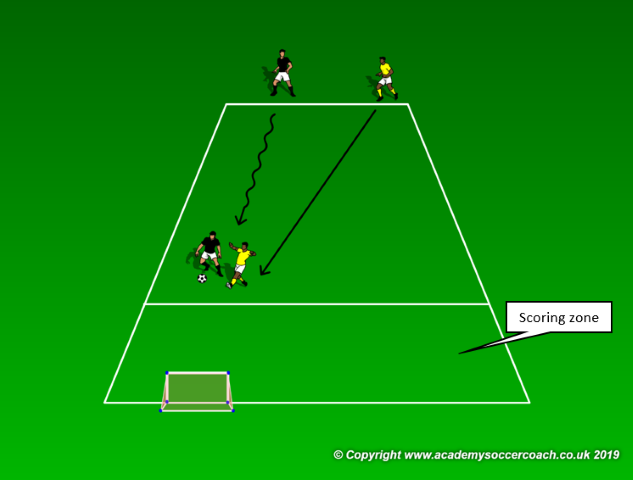
Remind players to focus on: 1) the ball and nothing else 2) forcing the attacker towards the side line and away from goal.
Area: 15 yards in length by 10 yards in width with a scoring zone 3 meters from the end line.
Players: Two teams one composed of defenders and the other of attackers.
Duration: 10 minutes.
Workload: 2 sets of 6 reps.
Description: Attacker starts dribbling forward at his discretion to score from inside the scoring zone. Defender must react quickly and defend accordingly. Players play one set as defenders and the next as attackers.
Game 1 – Defend outnumbered and counter in a numerical advantage.
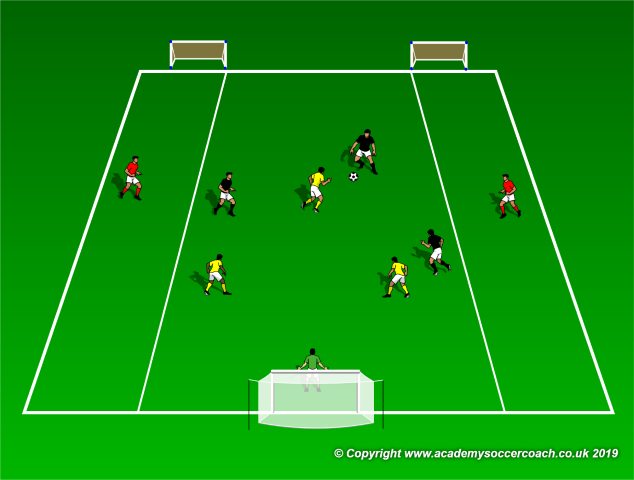
Remind players to focus on: 1) first defender applying pressure on the ball, 2) marking opponent ball-side and tight when close to goal and 3) first defender staying in the same line between the attacker with the ball and the goal.
Area: 30 yards in length by 20 yards in width with a flank zone on each side measuring three meters in width.
Players: The defending team is composed of three players and a goalkeeper, while the attacking team is composed of three players. Two neutral players are situated in the flank zones.
Duration: 20 minutes.
Workload: 4 x 4 minutes – interspersed with one minute rest between series.
Description: The team with three attackers aim to score in the regular goal defended by the defenders and goalkeeper. The neutral players play with the team in possession and if the defenders win the ball, they aid in the construction of a counter-attack. The neutral players are allowed to score when the attacking team is in possession of the ball. The defending team aims to win the ball and score in the mini goals positioned on the opposite end line.
Practice – 1v1 with the attacker receiving with his back to the goal.
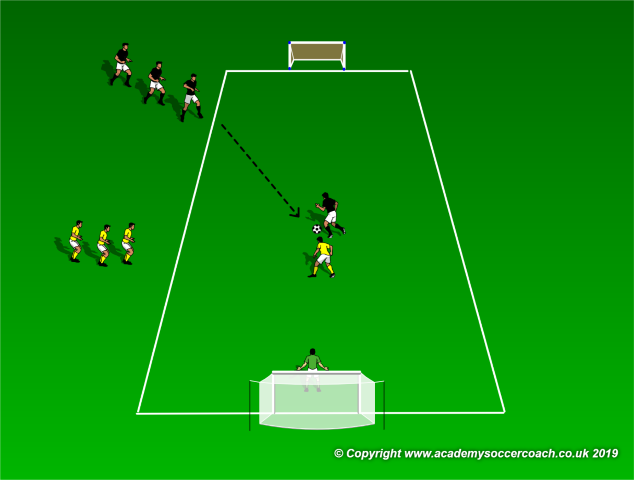
Remind players to focus on: 1) being able to see both the ball and the direct opponent, 2) not allowing the attacker to turn and face the goal.
Area: 20 yards in length by 10 yards in width.
Players: A goalkeeper in goal and a group of defenders and another of attackers. Have two setups playing simultaneously so to ensure sufficient repetition and session intensity.
Duration: 10 minutes.
Workload: 2 x 4 minutes – interspersed with two minutes rest between series.
Description: The attacker on the outside passes to the attacker inside the area. The defending player aims to prevent the attacker from turning and face the goal while trying to win the ball and counter on the mini goal. Players change roles after every repetition.
Game 2 – Defend outnumbered, win the ball and counter rapidly.
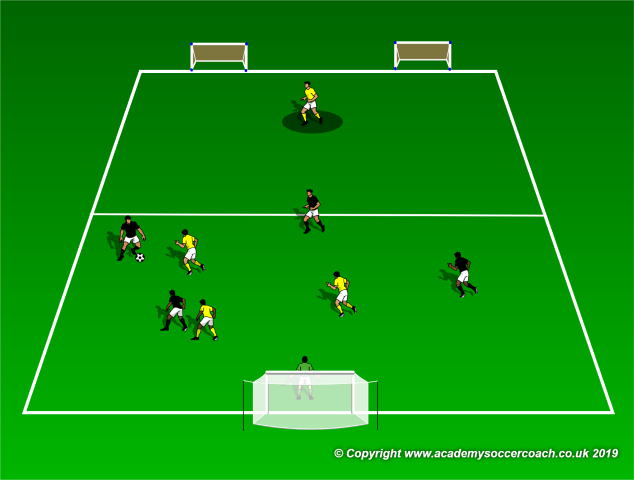
Remind players to focus on: 1) maintaining the appropriate distances and angles of coverage, 2) timing to apply pressure on the ball.
Area: 30 yards in length by 20 yards in width.
Players: The defending team has a goalkeeper in goal and four outfield players while the attacking team have four outfield players.
Duration: 26 minutes.
Workload: 4 x 5 minutes – interspersed with two minutes rest between series.
Description: The attacking team aims to score in the regular goal while being contrasted for space and time by the defending team. If the defending team wins the ball they aim to play it to the target player (shaded player) and follow play. The target player must lay the ball off to the other players to finish on the mini goals. Whenever a goal is scored or the ball goes out of play, the attacking team restarts play from the centre line by attacking the defending team’s goal. Play this game for two sets, then the last two sets as a free game.
Session number: 19.
Moment of the game: In possession.
Team task: Build-up.
Aim: Keep possession of the ball in numerical superiority.
Technical-tactical outcomes:
1. Staggered angles.
2. Quality of passes.
3. Direction oriented first touch.
4. Diamond shape.
5. Forward movement to provide momentum to the attack.
Duration of session: 84 to 90 minutes.
Number of players: 12 outfield players and no goalkeepers.
Equipment:
Balls (at least four).
Mini goals (two).
Bibs (four).
Markers. (Three sets of four colours each as per the first activity where we have three setups).
Session plan:
Introduction and description of aim and outcomes: 5 minutes.
Activation – Move to receive – passing: 10 minutes.
Game 1 – 4v4 with safe zones: 12 minutes.
Passing practice – Support the forward pass: 15 minutes.
Game 2 – 4v4+4 on four goals on a divided pitch: 15 minutes.
Game 3 – 4v4+4 on four goals: 24 minutes.
Stretching and recapitulation – 5 minutes.
Activation: Move to receive – passing.
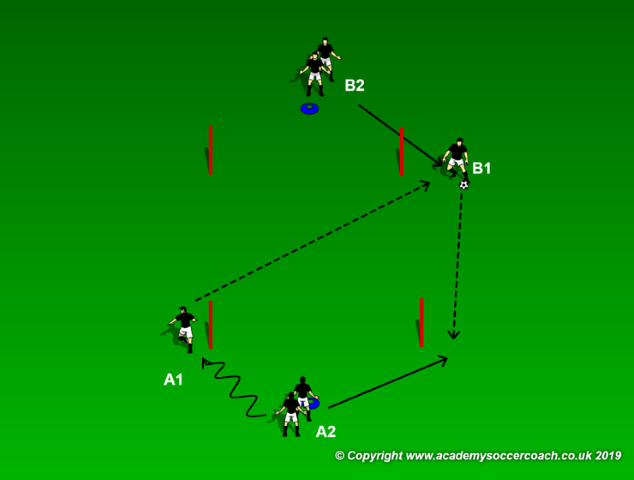
Remind players to focus on: passing the ball on the ground with the correct weight and accuracy.
Area: 12 yards in length by 10 yards in width.
Players: Six players, starting with three on each side opposite each other.
Duration: 10 minutes.
Workload: 2 x 4 minutes with two minutes mobility and dynamic stretching exercises in between.
Description: The exercise starts by having the ball carrier (A1) dribble to a pole and then pass to the player from the opposite line (B1) who has moved to receive the ball to the outside of one of the two poles. Immediately a player from the opposite line (A2) moves to receive the ball at either outside of the two poles. This sequence is continued. After passing, players move to the end of the opposite line.
Progression: Increase the length of the area from 12 yards to 15 yards. The player passing from one side must move to provide support and act as the wall player in a wall pass played by the receiver.
Game 1: 4v4 with safe zones.
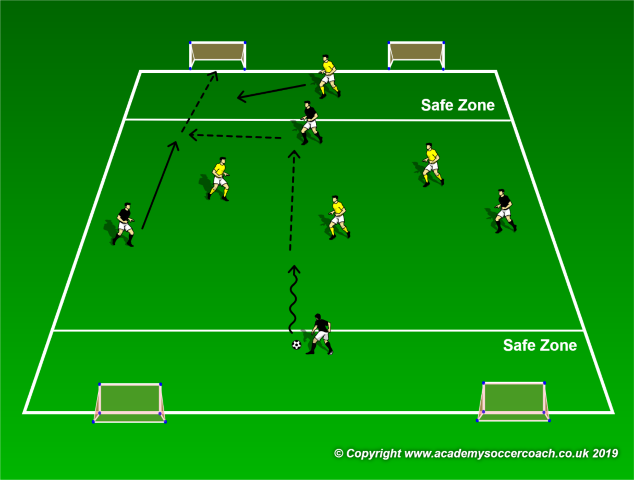
Remind players to focus on: 1) creating passing angles and 2) having width, depth and length in attack.
Area: 40 yards in length by 30 yards in width. Two safe zones are marked 5 yards from the end of each end line.
Players: Two teams composed of four players.
Duration: 10 minutes.
Workload: 2 x 4 minutes with two minutes rest in between series.
Description: Teams attack two mini goals at one end and defend the opposite two. Inside the safe zone, a designated player cannot be tackled. When not in possession of the ball, this player must remain inside the safe zone, while the safe zone player of the team in possession can move out of this area to make the situation 4v3 in favour of the attacking team. In the attacking phase the ball may be passed back to a player in order to secure possession of the ball.
Progression: Attacking player in the safe zone may be tackled. However the 4v3 situation in favour of the team in possession is still retained.
Passing practice: Support the forward pass.
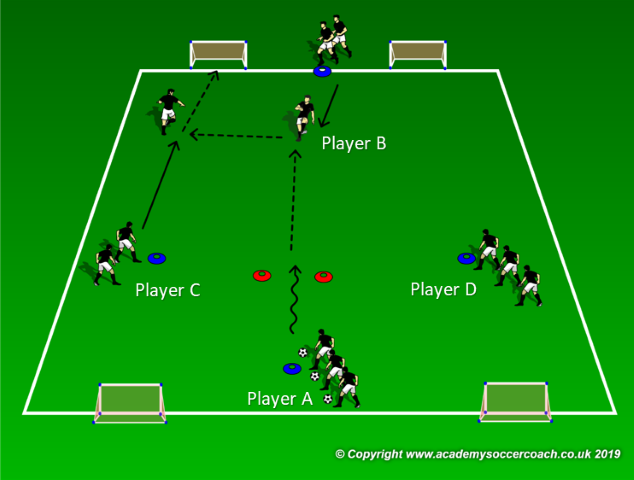
Remind players to focus on: 1) off-the-ball movement to give the attack forward momentum, 2) applying to correct weight to the pass and 3) stance to be able to play the ball efficiently.
Area: Same setup and dimensions of area are kept from game 1.
Players: Four groups of players are set in a diamond formation.
Duration: 15 minutes.
Workload: 4 x 3 minutes with one minute rest in between.
Description: Player A dribbles forward and once passing the red markers a vertical pass to player B is played. Player B should have checked back to receive the ball at his feet. Player B plays the ball to either his right or left to players C or D respectively. This pass is played alternately to players C and D. Players remain in their group for the whole three minutes, then rotate clockwise.
Progression: Play is switched to the opposite side. In the above diagram it would be that player C plays the ball to the opposite side to player D to finish on the mini goal. Here we can also introduce the counter movement by player C as if to get free of marking and receive the ball from player B.
Game 2: 4v4+4 on four goals on a divided pitch.
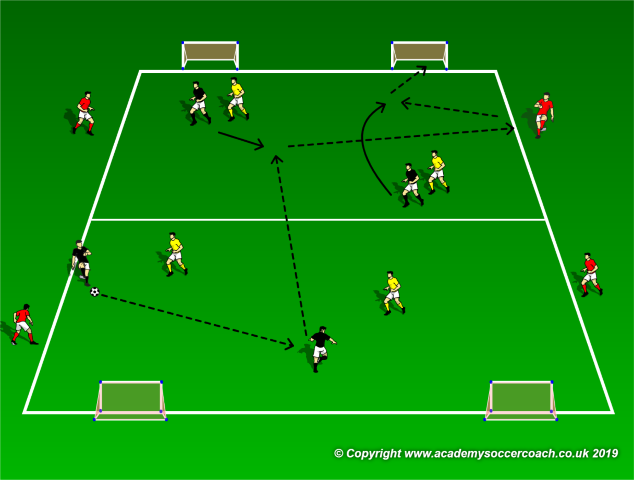
Remind players to focus on: 1) creating passing angles, 2) having width, depth and length in attack and 3) switching the point of attack whenever direct penetration is not possible.
Area: Same setup and dimensions of area are kept from the previous exercise. The pitch is divided into two equal horizontal zones.
Players: Two teams of four players inside the area and another four acting as neutrals on the perimeter as shown in the above diagram.
Duration: 15 minutes.
Workload: 3 x 4 minutes with one minute rest in between.
Description: Two players from each team are positioned inside each horizontal zone. Players are not allowed to leave this zone. In each half the situation is 4v2 for the team in possession (with the help of the neutral players). A goal may only be scored from inside the attacking zone.
Progression: An attacking player inside the defensive zone may dribble the ball forward but another attacker inside the attacking zone must drop to keep the team stable in case of a turn over.
Game 3: 4v4+4 on four goals.
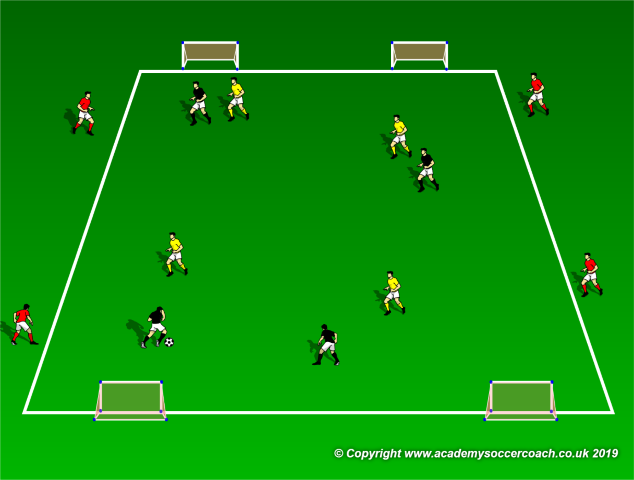
Remind players to focus on: 1) creating passing angles, 2) having width, depth and length in attack and 3) switching the point of attack whenever direct penetration is not possible.
Area: Same setup and dimensions of area are kept from the previous exercise, except now the pitch is not divided into two equal horizontal zones.
Players: Two teams composed of four players inside the area and another four acting as neutrals on the perimeter as shown in the above diagram.
Duration: 24 minutes.
Workload: 3 x 6 minutes with two minutes rest in between.
Description: Normal game except that the team in possession has four neutral players playing with them making the situation an 8v4. Neutral players are allowed to score and can also be contested for the ball by the defending team.
Progressions:
1. Neutral players may score but are not allowed to pass the ball to each other. They must always pass the ball to a player from the team inside the area.
2. As in progression 1 but the neutral players are not allowed to score.
Session number: 20.
Moment of the game: In possession.
Team task: Scoring.
Aim: Movements to create space to penetrate and finish on goal.
Macro principle:
Overload the middle channel to penetrate from central positions.
Sub-principles:
1. Lateral midfielders 7 and 11 tuck inside to become inside midfielders.
2. Striker 9 to provide height and create space and options to penetrate.
3. Staggered angles between offensive midfielder 10, lateral midfielders 7 and 11 and striker 9.
Sub-sub-principles:
1. Counter movement to create space to receive the ball.
2. Stance to receive the ball and play the first touch oriented towards the direction of the next pass or move.
3. Weight and direction (to feet or to space) of the pass.
4. Insertion runs into space in search of penetration.
Practice – 4v2 to score.
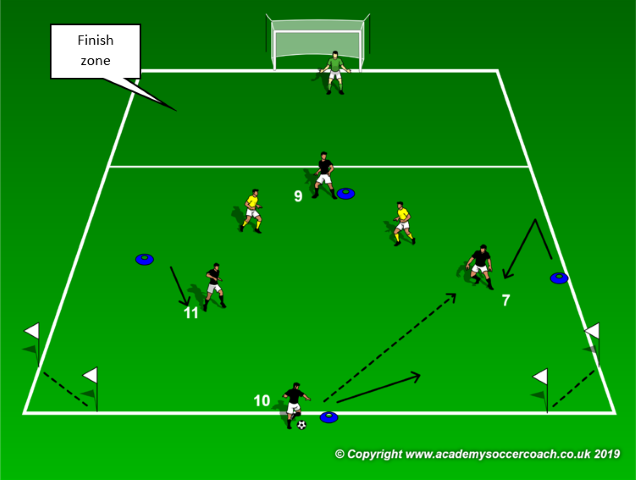
Area: 30 yards in length by 20 yards in width with additional finish zone measuring 10 yards in length.
Players: Four attackers starting in positions 7, 9, 10 and 11. These are opposed by two defenders and a goalkeeper in goal.
Duration: 20 minutes.
Description: Players start from the positions marked on the pitch. Attacker 10 starts the play after attacker 11 checks back to receive. This player may also check back by moving wider on the flank. Attacker 10 decides who to play the ball to or to dribble the ball forward himself. The aim of the attackers is to pass the ball into the finish zone to finish on target. If the two defenders win the ball, they counter on the two gates that are positioned at the opposite corners.
Progressions:
1. The attackers play two touch and aim to score within fifteen seconds.
2. Add another defender.
Game – 4v4 in four quadrants to finish at goal.
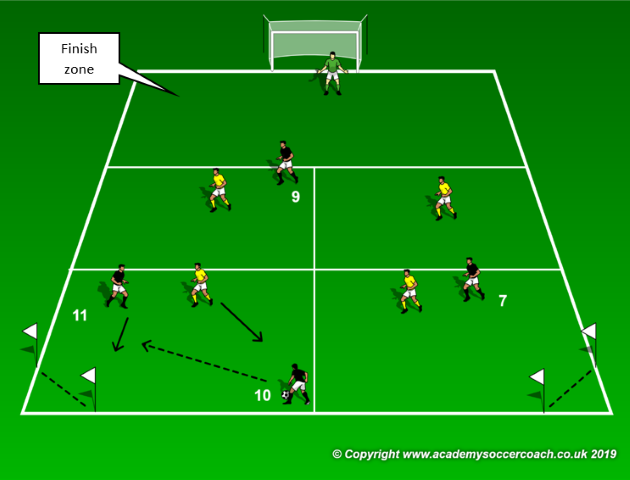
Area: 30 yards by 20 yards with a finish zone measuring 10 yards in length. There are also four quadrants each measuring 10 yards by 10 yards. Two corner gates 2 yards in length act as target goals.
Players: An attacker and a defender in each quadrant plus a goalkeeper in goal.
Workload: 4 x 4 minutes with one minute rest between series.
Duration: 20 minutes.
Description: The players of the defending team may only remain inside their assigned quadrant. The players of the attacking team may move along but only two of them may be in the same quadrant. The aim of the attacking players is to play the ball into the finish zone to finish with a shot on goal. Only the attacker on the ball and the defender responsible of his zone is allowed to follow into the finish zone.
Progression: A defender may also have two players in the quadrants. Therefore a 2v2 situation may be created in the quadrant.


